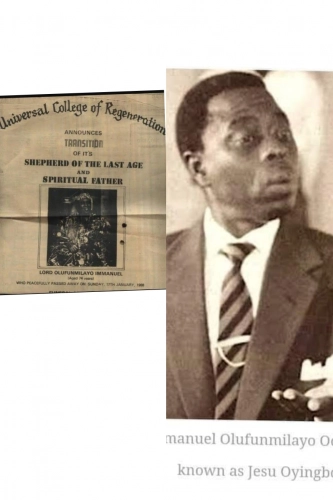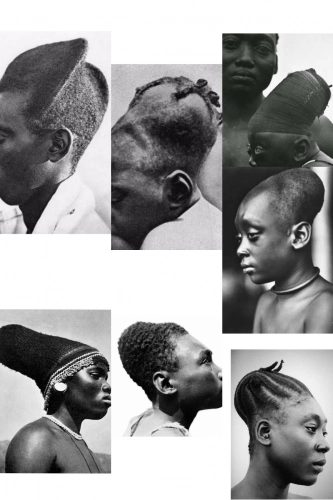Stories And PoemsCommunications And EntertainmentNews And PoliticsMotivationalsEntertainmentCelebrityStoriesNewsHealth And LifestyleRelationship And MarriageFood And KitchenReligion And PrinciplesRelationshipsHistoryPersonal Care And BeautyGeneralMoneyGive AidFoodLifetipsHobbies And HandiworksHealthPoliticsMotivationAnnouncementBeautyIT And Computer ScienceLifestyleComedySecurityMenBusinessGiveawayPrinciplesReligionHerbal MedicineLawSpiritualityFamily And HolidaysOthersScience And Technology
profile/7945received_5139201582833624.webp
Kweenshantel

This Is Jesu Oyingbo Or Jesus Of Oyingbo That Came To The World To Enjoy Life
~63.6 mins read
This is Jesu Oyingbo or Jesus of Oyingbo— Oyigbo is an area in Ebute Meta, Lagos State.


Way back in 1959, this man declared:
“I am He. I am Jesus Christ, the very one whose second coning was foretold in the New Testament. I have come and those who believe in me will have an everlasting life and joy. I am the missing of the trinity. I have come to prepare the faithful for the judgment day.”
Immanuel Olufunmilayo Odumosu made fame and wealth by proclaiming to be Jesus Christ in his messianic return.
He was a carpenter, had no formal education, and couldn't even enrol in a seminary. But he claimed he had a vision from God and that the Bible had been implanted into him, by God Himself.
The name of his "church" was Universal College of Regeneration (UCR).
As a man, to join UCR, you would get whipped nine times.
The opportunity for expansion came when one member of his so called church gifted him a vast swathe of land. He established chains of businesses within the premises of his church and called it the New Jerusalem.
He then encouraged his members to come live in the New Jerusalem. Members who moved into the "Jerusalem" all worked for free in his various business entities. This was how Jesu Oyingbo started rolling in wealth.
The vastness of his wealth was seen in the number of properties he acquired. When Oyingbo and its environ couldn't contain him, he moved to Maryland. In Maryland a street was named after him because his sprawling estate covered numbers 7a, 7b, 9, 10, 11, 13, 14, 15, and 17 on the street. He also had properties on 37 Aliyu Street, via Felicia Ayodeji Street, off Ikorodu Road, Ketu and 370/322 and 624 Ikorodu Road, Mile 12.
He said while Jesus came to sacrifice and suffer taking care of the cross-carrying and crucifixion, he, the second Jesus, “simply came to enjoy life”.
Since some members live in his New Jerusalem, he had access to a lot of women. He had over 10 wives and aside that, he had access to other female members of his cult.
Immanuel Odumosu had prophesied that he would never die, but unfortunately on January 17, 1988, the angel of death visited the ‘immortal’ Jesu Oyingbo at a private hospital in Lagos, where he passed on at the age of 73 years.
Credit:#apotheosisofknowledgefacts
profile/7945received_5139201582833624.webp
Kweenshantel

The Mangbetu People And Their Art Of Elongated Head Called Lipombo
~400.1 mins read
The Mangbetu are a Central Sudanic ethnic group in the Democratic Republic of the Congo, living in the northeastern province of Haut-Uele.
The Mangbetu people of Central Africa had a different look partly due to their elongated heads.
When kids were born, their heads were tightly wrapped with cloth in order to give it the elongated look.
The practice began fizzling out in the 1950s due to westernization.
Cc; Happy Africans
As the saying goes, “beauty is in the eyes of the beholder”. What appears to be a major deformity of the skull is considered a symbol of great beauty and social standing in the society by the Mangbetu people of the Democratic Republic of Congo.
The tradition, which is locally referred to as Lipombo, begins exactly a month after birth and continues for several years until the child acquires the preferred shape of the head.
The custom of skull elongation, called Lipombo by the natives, was a status symbol among the Mangbetu ruling classes, it denoted majesty, beauty, power and higher intelligence.
The practice started to die out in the 1950s with the arrival of more Europeans. It was also outlawed by the Belgian government, who ruled over colonial Congo.
Found in the remotest parts of northeastern DRC, the Mangbetu people have a distinctive physical appearance that is largely highlighted by their elongated heads.
In the 19th century, the Mangbetu tribe, whose name loosely refers to nobility, established several powerful kingdoms across Central Africa and later settled in northeastern Congo, where they practiced farming, fishing, hunting and gathering.
The group practices polygamous marriage, with its bride price being offered in the form of a substantial gift of livestock, while its lineage is normally patrilineal. The Mangbetu people are known for their impressive skills as builders, potters and sculptors.
Linguistic patterns indicate that the Mangbetu originated from the northeast, probably from modern day Sudan. As they moved southward they encountered Bantu migrations moving northward. They finally settled in their current homeland in the 19th century. This area had been occupied by the Mbuti. The Mangbetu intermarried with and subsumed many of the Bantu and pygmy populations they encountered. In the 19th century the Mangbetu Kingdom was established under Nabiembale and became the dominant political force in the region until 1880, when Sudanic and Islamic slavers entered the region, fragmenting the kingdom into sultanates controlled by Moslem leaders. When the Belgians arrived they expelled the slavers....
See More Photos:
Advertisement

Link socials
Matches
Loading...
